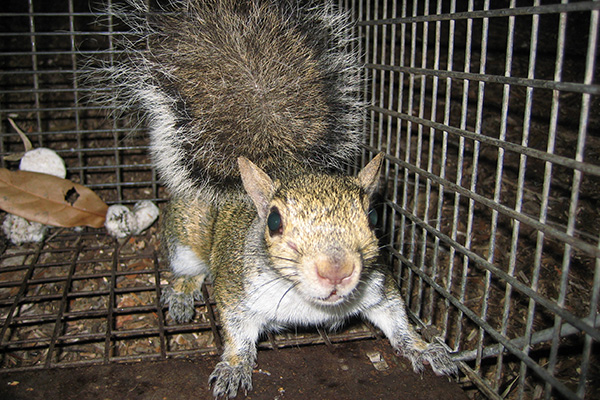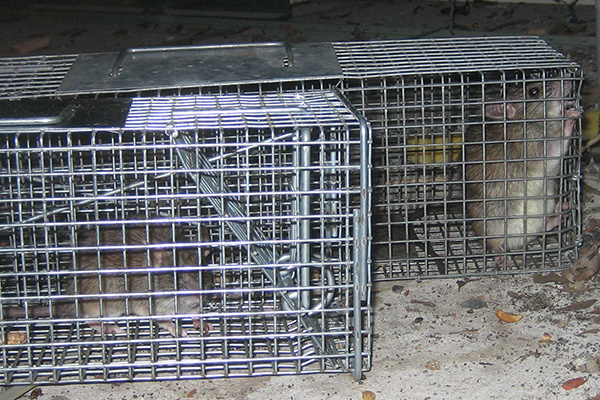- info@animalatticpest.com
- Call - we service 300 locations

Trapping Animals In Attic - How to Catch Critters in the Attic
Trapping animals in the attic is not simple. You are dealing with wildlife, and each type of animal behaves differently, especially given the specific time of year. There are so many variables. In fact, much of the time, the
best solution doesn't involve trapping the animals at all! For squirrels or bats, you are better off excluding the animals. And furthermore, the only animals that are actually trapped inside the attic are rats and mice, and
on occasion opossums. Other common attic pests such as raccoons or squirrels will not enter a trap inside an attic. Your best first bet is to identify
which animals you have in your attic, and then read the specific guide I wrote for how to catch that animal. Read my How To Identify the Animal guide for more advice.
Once you know what species of critter is in your attic, read about that animal here: squirrels, raccoons, rats, mice,
bats, opossums, snakes, birds, flying squirrels.
The first and most important key to trapping wildlife in an attic is in finding the entry holes into the house. You must use a ladder to inspect every part of your roof and all your vents. Look for poorly screened roof vents,
or places where the soffit meets the roof, or eave vents, or wooden fascia boards that they can chew through. Your home might have several entry areas. Next, get back in the attic, and you must inspect the attic and find the
nest of baby animals, if you're dealing with raccoons or squirrels or opossums or birds. You must remove
the nest of babies first. They can actually be used as "live bait" in a cage to trap the critters in the attic. Next, you need to either trap or exclude the animals, depending on species and situation. I advise you click on your
animal above for specifics. You must reseach the correct type of trap(s) to use in your situation, and buy them, and set them correctly. Raccoons and opossums require a large cage trap, at least 12x12x30, whereas squirrels are best
caught with a repeater trap mounted directly on the hole. If you want to know how to trap rodents in the attic, rats and mice are best caught with snap traps placed throughout the attic. Only after you are sure all the animals are out,
can you remove the traps or exclusion devices and seal the final holes. Read about entry hole repairs. After that, it's often a good idea to repair the damage in the attic, and clean the animal waste left behind.
Trapping Animals In Attic - How to Catch and Remove Critter in Attic
Trapping Raccoon in Attic
Inspect the exterior of the home, including the roof and all vents, to find out how the animals are getting in. Most animals in the attic enter at roof level.
Trapping Squirrel in Attic
This is very important. It will help you identify the animal species (look for droppings and tracks), and you will find out the extent of the animal damage.
Trapping Possum in Attic
You have to find out how they are getting in. Not all entry holes will be this obvious. Many will be behind vents, or small gaps where the eave meets the roof, things like that.
Information About Trapping Animals In Attic - How to Catch Critter in Attic
Traps are the best way to catch critters on your property that shouldn’t be there. With proper trapping, you will be able to humanely remove the animal in question. Just be sure to check your local regulations before trapping any animals in your attic as the laws will vary between cities and states and by the animal in question. In many cases, you aren’t legally allowed to disturb certain animals, like bats, during their maternity season due to species protections. In certain cases, it may be legal to trap a specific animal, but only if you kill it afterwards or bring it to a designated location; be sure you are aware of regulations to avoid a hefty fine.
Determine If There Are Babies
Before you get too far along in the process, confirm that there are no baby animals present in your attic. If babies are present, you have two options. The best choice will typically be to wait a few months until the young are old enough to be excluded or trapped by themselves. In cases when you need the animals out right away and they are not a protected species, you will need to catch the mother and then carefully grab the babies (while wearing gloves) and reunite them. Alternatively, you can grab the babies while the mother is out and use them as bait to catch the adult animal.
Prevent More From Entering
Once you have confirmed that it is legal to trap the animals in your attic, you need to make sure that no new animals can get inside the space. To do this, inspect the attic carefully so you can find every single potential entry point. You will then want to seal them all up to prevent entry. If you prefer, you can put an exclusion device over one of these points instead of sealing it completely. If you plan on trapping, however, this isn’t typically necessary.
Choose Your Trap
Selecting the type of trap to use is one of the most important things to do. In general, you want to always opt for a live cage trap as these will be the most humane. The only exception is in the case of rodents, which breed quickly. In that case, you can use snap traps which will kill the animal instantly when caught, making them the most humane method. It simply isn’t practical to live trap and relocate the quantity of rodents that typically live together as these are social creatures.
For any animal other than mice and rats, select a live cage trap that is large enough to hold the animal in question without providing too much additional space. Lethal traps will typically not be humane and may also be ineffective, so avoid them at all times. Glue traps, in particular, are horrible as they are more likely to pull off fur than catching the animal. If the animal is caught in one of these glue traps, they will die a slow, painful death. The trap you choose should always be selected with humane treatment of the animal in mind.
Bait The Trap
Next, you will have to select a bait for the trap. This requires a bit of research as each species has its own personal preference. Some, such as raccoons, are easy as they will eat nearly anything from leftover human food to pet food to rice. The best option for raccoons, however, is marshmallows as they are sweet and these animals prefer round, white things. Possums are also omnivores which are attracted to most items, but marshmallows or bread work well for them. In the case of squirrels, try spreading some peanut butter. This works well since squirrels love nuts and seeds but unlike the whole thing, they can’t try to grab the peanut butter and go and it will not fall out of place. You also probably already have some on hand.
Place The Trap
You will then have to place the trap in a location where it will be effective. Some traps can be mounted to the exterior of your home, right by the exit the wildlife in question would use to leave. Otherwise, put the trap somewhere it will be seen. In the case of rodents, look for signs of their paths and place the traps there; these are creatures of habit.
Check The Trap
After setting the trap, you need to remember to check it very regularly, several times a day. You never want to leave an animal in a trap for an extended period of time as it can die from starvation, dehydration, or exposure. At the very least, it may accidentally injure itself in an attempt to escape. Once you have caught the animal, you can relocate it to a safe area. Select somewhere at least several miles from your home and with easy access to food, water, and shelter to maximize the animal’s chances of survival.
The Bottom Line
Trapping is only part of the removal process, and in some cases, you don't actually trap at all. Trapping is an art - seriously, I'm not trying to make the job sound important, but there are just so many variables, and most amatuer attempts go very poorly due to simple lack of knowledge and experience. I recommend professional help for animal trapping.




